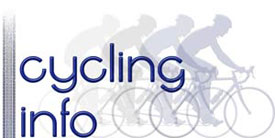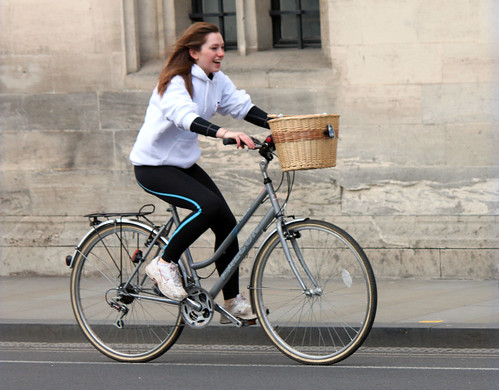Most people who cycle into town do so because it makes the most sense given the various options of travel. When deciding how to travel, we examine:
- Relative Cost
- Enjoyment / fear of danger
- Time Taken
- Convenience (e.g. can we park near our destination) Do we have to carry waterproofs)
To encourage cycling, you need to tackle some or all of these.
Increasing Car Parking charges.
Effective for raising the relative cost of driving into city centres. A £3 parking charge makes a big difference to discouraging car use in city centres. My old landlord started cycling the 1 mile to work, exactly because his work no longer gave him a free car parking spot. (used to work for Oxford University). He said the first time he cycled the 1 mile to work his legs felt like jelly, but now he’s very enthusiastic about cycling the 2 miles every day.
Pedestrian Areas.

I often wonder why Oxford has so many cyclists, when some facilities seem very inadequate. The biggest reason is probably students, but one important reason is that some key roads in city centre are either pedestrian or semi-pedestrian. When you get to these roads, it feels like a cyclist paradise. It really is enjoyable cycling without cars and buses breathing down your neck. It doesn’t last for too long, but, even small efforts to remove vehicles make a big difference. Also pedestrian areas and one way systems effectively increase the relative time taken for driving compared to cycling.
It is no surprise that Amsterdam’s boom in cycle use came after
- Imposing more one way systems
- Limiting car access in key areas
- Increasing parking charges.
Real Cycle Paths

A good cycle path.
A real cycle path is one that actually feels safe. It’s not a small line painted onto a narrow road, but one that offers some separation to other road users. This simply makes a big difference for ‘novice cycle users’ – The mum’s carrying kids on bike e.t.c.
Lower Speed Limits
Sometimes your negotiating a roundabout and a car overtakes at a seeming 30mph, it’s scary – no statistics about how cycling is relatively safe can change the fact cycling becomes stressful. Imposing 20mph zones (i.e traffic calming measures to reduce speed and enforce 20mph limits) make a huge difference. It’s also no chance that a car hitting someone at 20mph has only a 10% of fatality. At 30mph this increases to a 50% chance of fatality.
Cycle Provision
Good cycle stands. facilities at work to change.
Culture of Cycling
It is simply easier to encourage people to cycle when cyclists are more visible. In other words there can be a bandwagon effect, once more people cycle, this in itself encourages people to cycle. This is why cycle rates in cities can vary from 0.1% in Bradford to 20% in Cambridge (approx I remember these off the top of my head). Cycle campaigns which raise awareness and show how it is practical to cycle do make a difference in the long term.
Related



The problem here (West Wiltshire) is that it is very hilly. The standard response one gets to the suggestion that people ‘get on their bikes’ is that there is too much ‘up’, and not enough ‘down’. It is true that we have the Kennet and Avon towpath, but that suffers from wear and tear. We also have a lot of traffic, and a County Council that is, reputedly, half-hearted about cyclists in general. I hope that pressure will mount for 20mph limits but, with the volume of traffic increasing by .5% annually (not far off 36 million at the moment), we will need drastic action before people feel safe.
It’s not just having lots of students.
The University of Manchester is the biggest single site University in the UK in terms of studentnumbers, and shares the “Oxford road corridor” with Manchester Metropolitan (the second largest after UoM) as well as other colleges.
The main halls are some three miles from town, with the universities spread out in between. It’s really flat, and cycling would perhaps seem to be the obvious choice for students on a budget. There are a few but Oxford blows Manchester out of the water in terms of cyclist numbers.
Why? The main reason is dangerous roads full of buses and other traffic, where the reality is quite bad but the perception is even worse.
Also, there is a real issue with crime. Bikes go missing quickly if not securely locked and even those that are sometimes get vandalised. I was gobsmacked to see bikes in Oxford just locked to themselves, and not to any street furniture. They wouldn’t last two minutes in Manchester.
Mind you, cycling is still far and away the quickest easiest cheapest healthiest way to get around Manchester.
We are trying to knowledge-share and spread expertise about good cycling design through out new yearbook and trade directory for utility cycling – commuting, go shopping, travel to schools. Cycling needs to be seen as just another form of urban travel like driving or getting the bus, not just as a sport or leisure activity or fringe interest.
See http://www.transportxtra.com/getbritaincycling
Please let me know what you think by email – gbc@landor.co.uk
A brilliant and well thought out post. My friend and I were cycling out of Southampton to go to the New Forest, the only way out is adjacent to the A35 on dual use pavement, that or cycle on the 50mph dual carriageway. Until traffic planners make a concerted effort, above and beyond painting lines, then nothing will change drastically.
I’m trying to convince my girlfriend to cycle the 2 miles to work (would take her 10 mins max), rather than drive every day and she wouldn’t get stuck in school traffic on the way home. But she starts work early and isn’t very convinced. Too early, too cold, can’t come home on lunch breaks. Oh, and her bike got nicked…
>cycling the 1 mile to work
Blimey! I’d not even bother getting the bike out for such a short distance, let alone a car — at that sort of range, the time spent in getting set to go and parking at the other end reduces the marginal advantages of speed en route.
The main uphill battle is getting people to realise that some light physical exercise isn’t going to kill them.